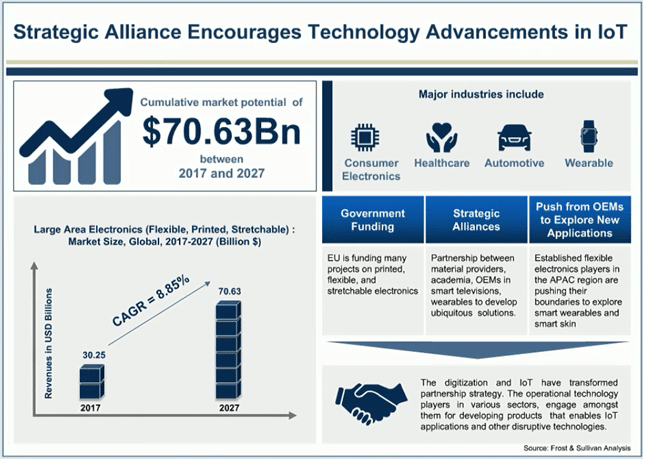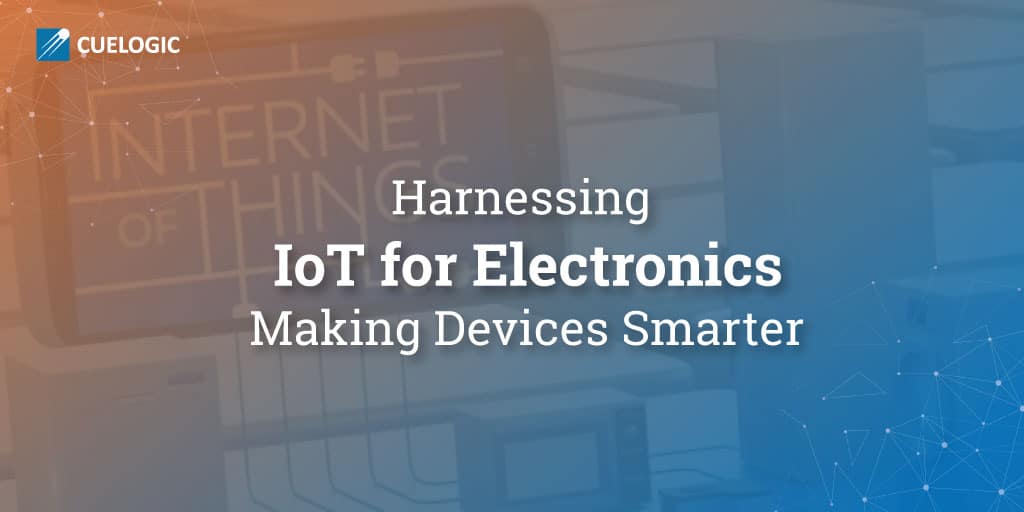Introduction of smart electronic devices in IoT is nothing less than a game changer. Companies investing in this unexplored territory will reap the benefits of IoT.
Many innovative and smart IoT electric devices powered consumer electronics products are disrupting the market, these IoT connected devices can talk to consumers as well as to other machines. Such disruptions will be taking the consumer electronics industry to the next level.
Industry experts predict that what you see today is just the tip of the iceberg. With the help of IoT for electronics and connected devices, the electronics industry will be growing at a Compounded Annual Growth Rate (CAGR) of 8.85% from 2017 to 2027.

As you can see above, consumer electronics, healthcare, automotive and wearables are the major industries getting impacted by the IoT revolution. Industry players are partnering and collaborating across industries to find out how smart electronics devices in IoT can be used in connected devices?
How does the connection between smart IoT devices and electronics help?
These intelligent, energy efficient, smart electronic devices in IoT have functionality like sensing, actuation, and control. They are always connected to the manufacturer’s network via the internet and can send information about product performance, usage trends, and energy consumption to the manufacturer.
The company engineers can use such data coming from the entire network with the help of Artificial Intelligence and Machine Learning to make them more intelligent.
https://www.youtube.com/watch?v=rYdqx9KJH58&feature=youtu.be[/embed]
For example, a smart electric device with IoT capabilities like a washing machine has many sensors across its body. It can transmit data such as water usage, use of certain features, the health of the appliance, ambient and water temperature etc. to the manufacturer.
- The company design engineers can use the product performance and usage patterns to design the next product.
- The operational data can be used to predict product malfunction and to plan for repairs.
- The malfunction related data can be used for preventive maintenance schedule and to update the custom software made. This software update can be applied to all the machines in the entire network without human interaction.
- The marketing team can find out high sales locations and the models purchased across different market segments. This information can be used to plan marketing initiatives to gain more customers from different segments and to engage with consumers via social media to provide them a better experience.
- Based on geographic location, the company can build a network of repair techniciansand accessories vendors to further enrich consumer experience.
So the washing machine is talking to the manufacturer network and to other washing machines via a server with the help of IoT and IoT App Development.
The next level of automation using IoT is when your garage door opener is asking the light bulb to switch off once your car is gone or your smart lock is telling all the lights in the house to switch off once you leave the home.
How does IoT for electronics make devices smarter?
All these smart electronic devices in IoT enabled devices to produce an enormous amount of big data through various sensors. Big data in IoT makes no sense unless it is analyzed and presented to the stakeholders in a relevant and understandable format.
The consumer might be interested to know how to save energy? The company management might want to know how to improve product performance and sales?
Traditional data analysis techniques can be applied to the past structured data along with expert opinion to create relevant reports and data models.
But Machine Learning (ML) starts with a question or goal and works with rapidly changing unstructured data to answer the question. It uses algorithms to identify patterns and anomalies.
For example, from the data provided, it can identify which variables are important for saving energy and how those variables interact with each other. ML algorithms use this information to answer the question on how to save energy.
Machine learning helps you when you know your goal but don’t know how to achieve it.
Machine Learning algorithms constantly improve as more data becomes available. They can also predict future events. The algorithms can make predictions and later compare how close real events were and make adjustments to be more accurate next time.
For communication between devices, various internet messaging protocols are used depending on the need. For example, to send data from a device to the server Message Query Telemetry Transport (MQTT) protocol is used. When you want machines to communicate with each other, Data Distribution Service (DDS) protocol can be used.
Conclusion
Connecting more and smarter electronic devices in IoT with each other and with the server is the way to make them smarter because Artificial Intelligence feeds on data. More data to analyze will make the machine learning algorithms more accurate and thus smarter devices and happy customers!
